Grain system designs are complex. There are so many moving parts and dependent factors involved that can significantly affect your facility’s efficiency and profit. When you’re designing a grain handling system, including every necessary element can be a daunting task. From location to layout to custom-designed equipment, you want to make sure your facility starts on the best possible foot. It’s certainly worth thinking through these factors before launching into construction.
With numerous elements to organize before building, it’s critical to recognize the principal parts and pay attention to them throughout the process. This guide will take you through some of the top factors you’ll need to consider while planning a custom-engineered grain facility.
View Our Grain Storage Solutions
The Location of Your Grain Facility Is Critical
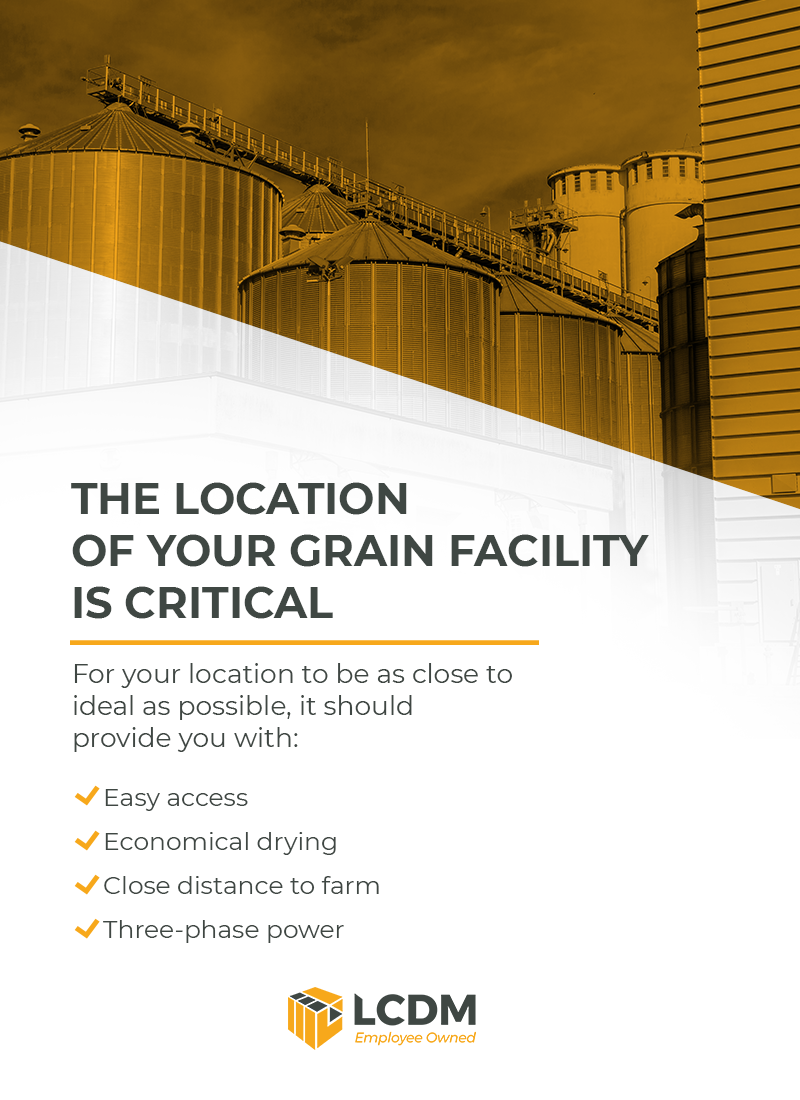
One of the most crucial elements to consider when designing a grain facility is the location of your farm system. Your plan needs to factor in the possibility of growth in your yield as well as the future evolutions of farming technology. For your location to be as close to ideal as possible, it should provide you with:
- Easy access: Travel routes are essential to hauling grain. The closer your facility is to a major road, the easier it will be to access your storage year-round. While being right off a state highway is the best possible option, distance from an expressway shouldn’t necessarily rule out a property. However, it is important to understand that a higher potential for road restrictions — especially considering inclement weather — means you may encounter more hindrances when hauling grain.
- Economical drying: Natural gas is the best option for drying grain, as it is more cost-effective and will provide you with a higher return on investment (ROI) than alternatives. If you can’t get access to natural gas, you can still use liquid propane, but it’s more expensive and will lower your overall ROI.
- Close distance to farm: Your field and farm system should be close to each other. Having a short distance between the two or on-farm storage will provide you with several benefits, including reduced fuel expenses, decreased transportation time and the opportunity to cut down your fleet of trucks.
- Three-phase power: Smaller farm systems may be able to operate perfectly fine with a single-phase power system. However, as your farm expands and you require larger machinery and motors, you’ll need access to more power. Single-phase might not cut it, and three-phase is ideal. Typically, you’re more likely to have access to three-phase in locations on major highways.
The more of these elements you can include in your location, the better set your farm system will be. These features make the harvesting and hauling processes more efficient, and they also provide a better foundation for future growth and expansion. With access to main roads, a reliable and cost-effective drying system, closeness to the fields and three-phase power available, your farm system will start off with the best possible conditions to flourish.
Corrugated vs. Smooth-Walled Bins
While location is crucial to operations, the material you choose for your storage facility matters for keeping your stock healthy. Grain bins are what ensure your product stays top quality, so it’s necessary to consider the storage medium. Your best options for grain longevity and preventative protection are smooth-walled or corrugated bins.
Both styles are made from galvanized steel, making them extremely durable. The material is also highly resistant to the elements, making it perfect for all weather conditions and outdoor uses. For long-term dry grain and short-term wet crop storage, galvanized steel will suit your needs. However, there are differences between corrugated and smooth-walled construction. Your decision should come down to the kind of farm you run.
1. Corrugated Bins
If you run a large farm that produces a lot of grain, corrugated bins are the better option. Their resistance to friction is a huge benefit. During the loading and unloading of grain, the dynamic movements cause a lot of pressure within the walls of the storage system. Corrugation provides an uneven surface, which causes the pressure to remain stable and balanced. Because these bins can take so much pressure, they meet the needs of large farms and can hold far more grain than the smooth-walled variety.
However, there are a few downsides to choosing corrugated silos. They typically have a more complex design, making them more difficult to upgrade over time. Also, they’ll have a higher equipment cost, so you’ll have to commit to a larger investment.
2. Smooth-Walled Bins
For small to medium farms, smooth-walled bins are more beneficial than the corrugated variety. The construction is simpler, making it a less expensive investment that will pay itself off sooner. Also, most smooth-walled bins are built with the intent to upgrade, making it a simpler process than with corrugated walls. If your capacity begins to grow, you can expand your silos with relative ease.
The only downside is that flat steel does not have the same stability level as corrugated steel. Since smooth walls have a lower resistance to friction, they can’t hold as much grain, as the pressure during bin loading and bin unloading would be too high. If you need a higher capacity, you’d either have to upgrade to corrugated steel or install another smooth-walled silo.
Plan Ahead for Additional Grain Bins

In the grain industry, it’s always best to plan for future expansion. Considering the potential for growth is a crucial part of designing a grain storage facility that will suit your needs for years to come. You’ll need to leave space in your facility for adding grain storage bins. Regardless of where you begin, you should always factor expansion into the original design. As you plan the need for more bins, you’ll also need to pay attention to:
- Wet storage: As your business grows, your storage capacity for wet bushels may not be enough. Increasing the amount of grain you dry will create the need for additional wet storage, which you’ll need to allow space for from the start.
- Dryers: While you need to plan for additional wet storage, you have to match that expansion with dryers. Your facility should have a reliable and appropriately sized in-bin or out-of-bin grain drying system to start. You should also consider the potential need for dryers with higher capacities. You may need to install multiple, depending on how rapidly your yield and bushels increase.
- Segregated grains: The number of bins you’ll need is dependent on how many types of grain and how much of each variety you intend to store. Simply put, you’ll need a minimum of one bin per variety of grain. While the sizes of each bin are bound to vary, you may want to invest in multiple bins for each type of grain, rather than storing them in single, large bins. Not only will it offer you more flexibility and be easier to manage, but it’ll also help protect your yield. If something goes wrong with one of the bins — mold growth, for instance — you won’t lose your entire stock of that grain type.
- Traffic: Though you may currently be able to load and unload grain from the same station, as you expand, this setup might be unnecessarily time-consuming. If you design your storage facility with two separate stations — one for dumping grain, the other for loading — you’ll be able to move faster and decrease time spent harvesting. Maintaining operational efficiency becomes essential as you add more bins.
If you design your storage facility without leaving room for potential expansion in your initial plans, you may run into major snags later down the line. Trying to create additional space may prove to be difficult, disruptive and unnecessarily costly. Planning for it from the start will allow you to transition smoothly into growth and accept new opportunities as they present themselves, ultimately benefiting your business with as little hassle as possible.
What Are You Storing in Your Feed Mill?
Feed mills are essential to the functionality of farms. As the demand for specialty feeds has increased over time, feed mill designs have shifted to match it, resulting in larger and more complex facilities. The grain elevator design came from the necessity to create increasingly large facilities with more efficient operations. There has also been an increased emphasis on customization, where designers stray from the traditional feed mill plant and focus on enhancing specific functions.
One of the first things you need to consider in designing a feed mill is determining the types of products you’ll be processing. You should aim toward providing several options rather than producing a single type of feed. The variety of feeds produced by mills includes feed for all kinds of livestock, such as poultry, swine and ruminants, as well as domestic animals and fish.
Each of these feeds requires different grains and ingredients. In addition to the regular versions, there is a rising demand for feeds that are organic as well as free from GMOs and antibiotics. Rather than separate different types of feed mills, many facilities produce multiple varieties and keep them all separated in bins to avoid cross-contamination. This kind of operation requires a custom feed mill layout with additional equipment.
To accommodate the different varieties of feed, mill design plans need to include individualized storage. Depending on how many different feeds you intend to produce and store, you may need several silos for the finished product and grain bin site layouts for pre-processed ingredients. When it comes to storing product, the surrounding material matters. One of the top options for silos is engineered structural steel.
While there are some issues with the cleanliness of steel silos, it all boils down to maintenance. Installing liner panels, adding dust containment systems and putting in thorough and consistent service effort can keep the mill sanitary and prevent contamination.
Quality Grain Handling Equipment
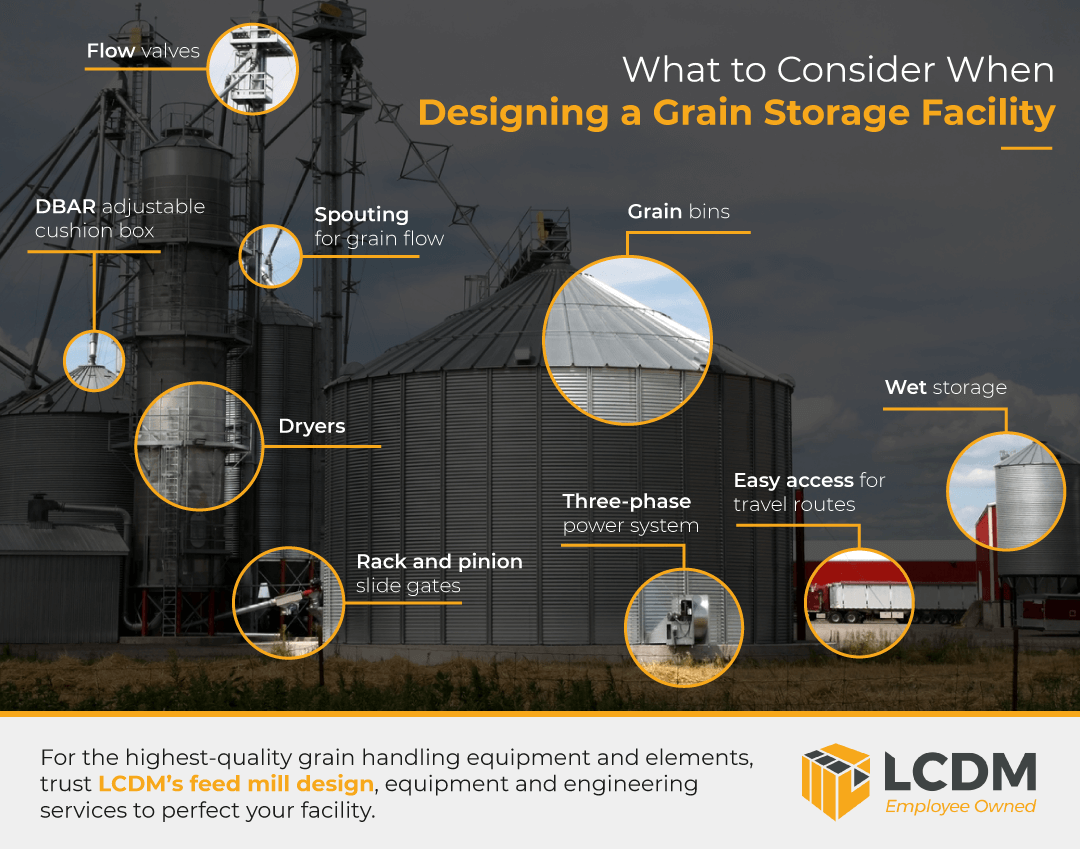
When it comes to choosing the proper equipment for your grain storage facility design, quality is critical. We understand the importance of designing equipment from a facility manager and millwright’s perspective. If you skimp out on quality in an attempt to save money in the short term, you’ll likely end up losing more money in the long run. Repairs and replacements take time and money, and improper equipment can take a toll on your ROI. But finding the best quality hardware available can have the opposite effect and allow your business to grow and improve.
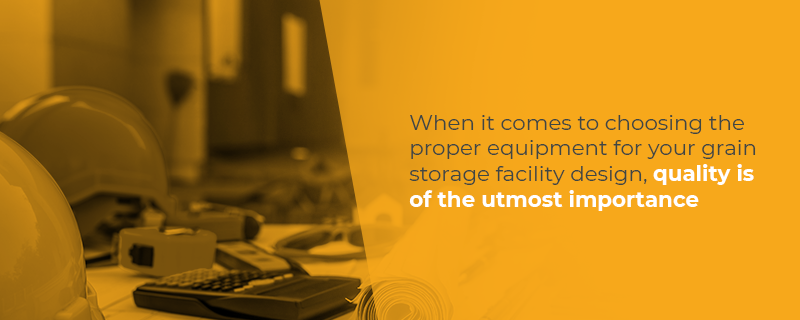
Here is some of the equipment you should consider implementing in your facility:
- DBAR adjustable cushion box: Using low-quality equipment can result in grain damage and loss of product. LCDM has a reliable solution, one that can reduce handling damages by 50% or even eliminate the issue completely. The Dead Box Adjustable Round (DBAR) unit collects and cushions grain, even when your spouts are operating at a reduced capacity. You can set the level of cushion you need with the adjustable baffle so it operates to your expectations. The eight-gauge body, galvanized finish and replaceable inner components provide longevity and consistent high-level performance. With a DBAR cushion box, you’ll benefit from superior grain quality, efficiency and an increased ROI.
- Flow valves: Valves are a major part of the grain handling system. They allow you to control the speed and amount of grain that flows from the point of discharge. If you don’t have top quality valves, you may encounter issues like flow restriction or loose seals, resulting in grain leakage and external contamination. These problems can cause large losses in product and severely hurt your ROI. LCDM manufactures quality full flow valves that form a seal with the spout and handle all capacities, ensuring your systems won’t suffer from restriction, leakage or contamination. They come in multiple custom sizes and configurations to provide the perfect fit.
- Rack and pinion slide gates: An essential part of grain handling, slide gates control the flow of bulk materials at multiple points of discharge, including on conveyors, hoppers and emergency shut-off sites. Some common problems that occur with low-quality slide gates are grain leakage and unexpected seize-ups, which can cause significant product loss and waste your valuable time. With a custom grain flow rack and pinion slide gates, LCDM can provide a solution fit for any material handling system. The inlet collars ensure a tight, leak-proof seal, and the steel rollers and bushings stay lubricated, refusing to seize. With flexible designs made from steel, these slide gates help keep your storage and handling operations running smoothly.
- Spouting: Depending on the type of grain flow process you use, your handling systems will require specific types of spouting. Without the proper spouting, grain handling systems are unable to function. It’s crucial that you install the most efficient and high-quality spouting you can find in your budget range. LCDM recognizes the need for reliable custom spouting solutions, including seam-welded and removable lid varieties in standard and square forms. With options that fit your specific processes, you’ll have access to the most efficient spouting for your facility.
- Sump saver: A sump saver ensures proper grain flow in your grain bin by rapidly slicing, dividing and eliminating clumped or frozen grain. LCDM understands that when moist clumps of grain plug your auger, you’re looking at costly delays and hazardous repairs. The sump saver unit works inside the grain bin to prevent these hazards and delays, keeping you safe and saving time and money.
- Dust suppression hopper: Too much dust in grain storage facilities increases fire and explosion risks. It also reduces visibility, which can create other hazards. Installing a dust suppression hopper in your grain handling facility is a great way to help keep everyone safe. Dust suppression hoppers also reduce air pollution and increase workplace efficiency. Our dust suppression hopper is easy to install. You can install it underneath a feed point, where it acts as a grain loading spout. In this way, the dust suppression hopper also speeds up loading times.
- Silo level monitoring systems: It is crucial to know your precise inventory levels when you manage a large-scale grain handling system. LCDM’s silo level monitoring system uses laser sensors with a rugged mounting system and a user-friendly app for simple monitoring. The sensors can detect densities as low as five pounds per cubic foot and as heavy as 100 pounds per cubic foot.

While this is just a partial list of the equipment you’ll need to pay attention to, these pieces of equipment will make a significant difference in your ROI and day-to-day operations. There are also several other elements, including flow retarders, elbows, distributors and other additional accessories. If you partner with a reliable engineering service, you’ll be able to find high-quality equipment for every part of your design.
Feed Mill Design and Engineering Services From LCDM
With LCDM in your corner, you can make your grain storage facility design into a reality. Our handling products are carefully designed with industry-leading quality and your ROI in mind, so you have the best possible options at your disposal. We use our state-of-the-art Solidworks design software to ensure we get every piece of equipment right on the first round of manufacturing, providing you with the best fit for your applications.
Not only will we spend time creating site designs and solutions that fit your needs, but our professionals will also walk you through the design process. At LCDM, we put our experience to work for you, while keeping you involved every step of the way.
Start your partnership with LCDM — contact our design team for more information today.

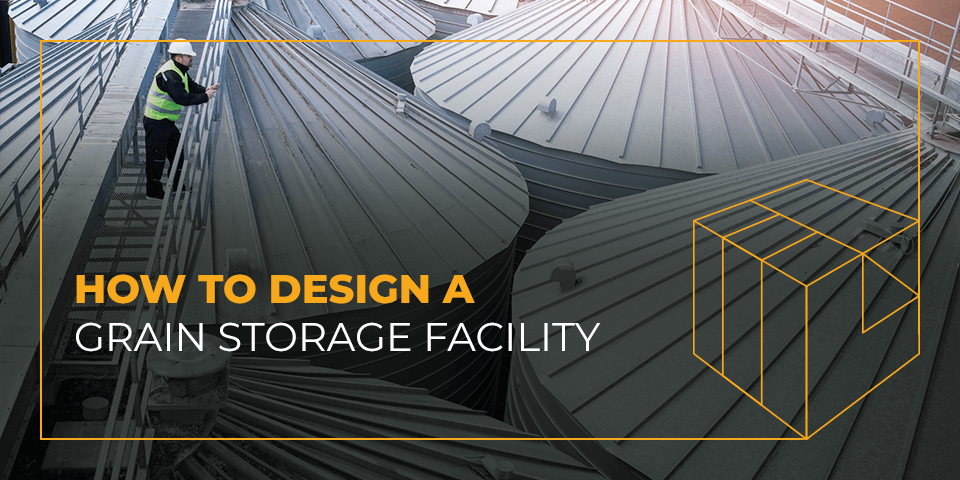


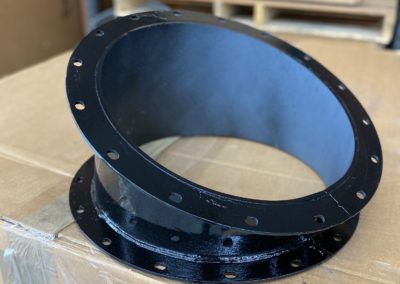
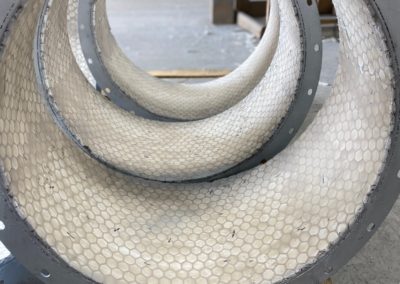
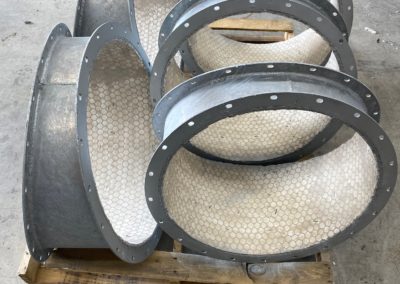

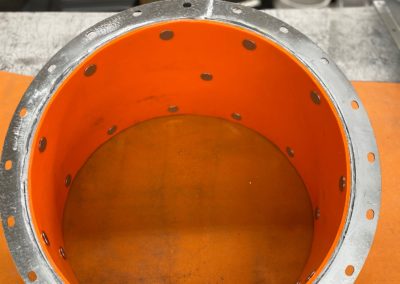
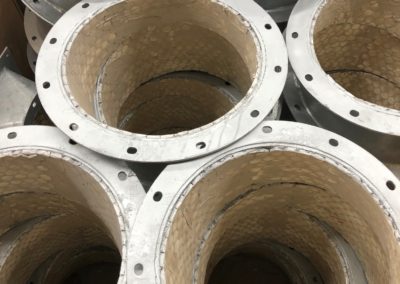
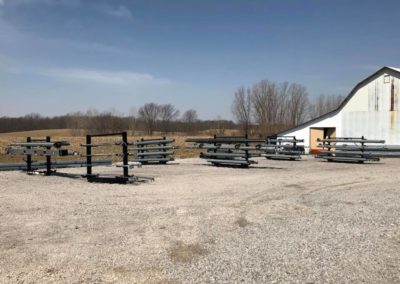
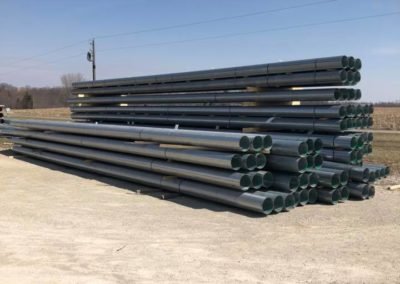
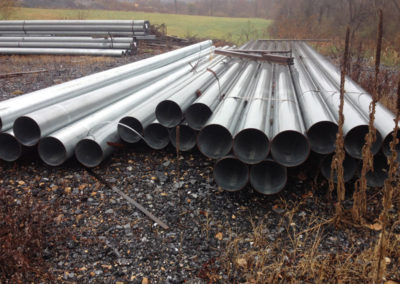
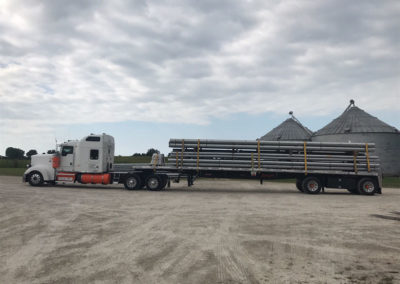
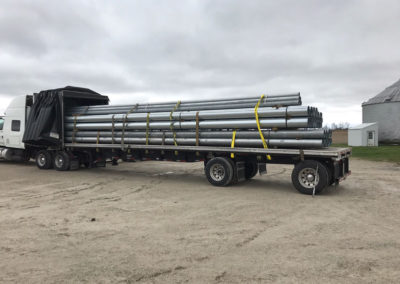
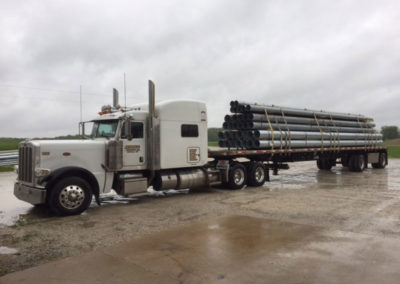
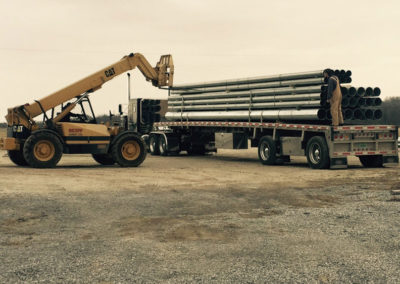
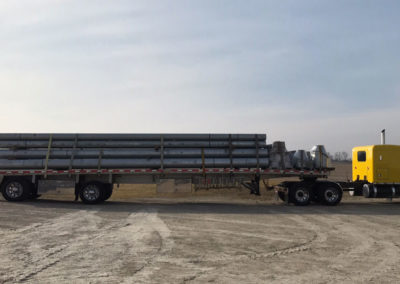
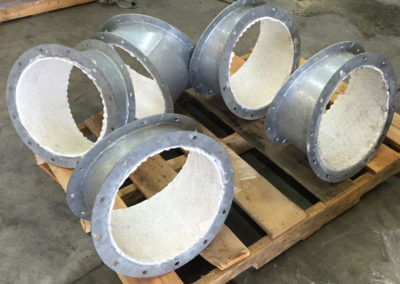
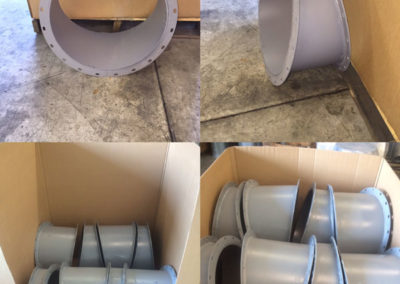
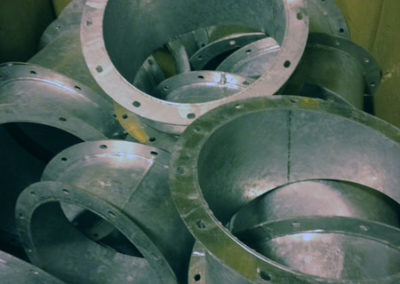
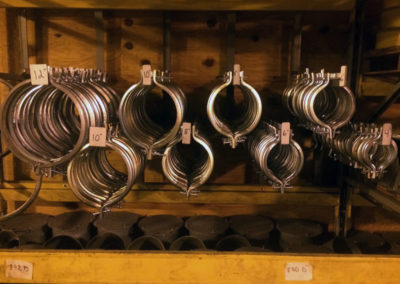
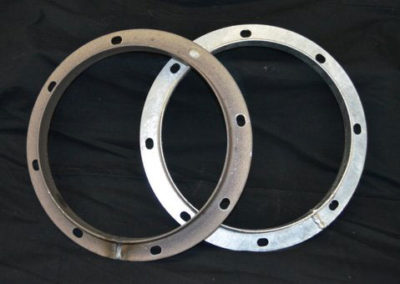
I like how you mentioned that grain handling facilities have changed over time to match the increasing needs for specialty feeds. The farm my brother works on is considering looking for a feed mill service because they’re thinking about getting more animals that require a special diet. I think it’s a good idea to consider hiring a reputable service that has the capabilities in order to the grain they need to be able to feed the animals they’re thinking about getting.